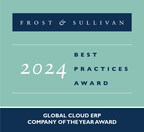Job Architecture Frameworks Are Critical for More Consistent Job Titling and Organizational Growth, Says McLean & Company
Global HR research and advisory firm McLean & Company suggests that without a structured approach, job titles can quickly become confusing and meaningless. This confusion can lead to long-term challenges for internal equity and organizational growth. The firm advises that it is important for organizations and their HR teams to invest resources upfront in creating a solid job architecture framework that supports organizational priorities.
TORONTO, Feb. 15, 2024 /PRNewswire/ – As a challenging labor market and uncertain economic times continue to impact both employers and employees across a wide array of industries, the need for intentional and data-backed approaches to talent acquisition and talent management has never been higher. A job architecture framework is a crucial component of an effective HR strategy and plays an impactful role in job titling, lending itself to supporting internal equity and organizational growth. HR professionals seeking research-informed resources to strengthen their organizations in the unpredictable future of work can access Develop a Job Architecture Framework, an industry blueprint from global HR research and advisory firm McLean & Company.
In the data-backed resource, the firm explains that a defined job architecture framework aligns roles within the organization using job levels and provides the necessary foundation for the organization’s approach to job titling. Job titling refers to the process of assigning a name to a job that conveys the job family or function and the degree of responsibility associated with the specific role. Job titles are determined based on the organization’s job architecture framework, which is achieved through job leveling, the process of systematically applying job level criteria to individual roles.
“A job architecture framework provides foundational support for other HR programs, spanning the development of competency frameworks, career frameworks, base pay structures, as well as learning and development initiatives,” says Amani Gharib, PhD, director of HR Research and Advisory Services at McLean & Company. “Without clearly defined job levels and criteria, internal approaches to job titling, pay grades, and career paths can be subject to bias and favoritism. A clear and defined job architecture framework removes the guesswork, decreases liability, and supports internal equity.”
To help HR leaders develop and communicate a job architecture framework that supports the long-term success of the organization, McLean & Company has divided its blueprint into three easy-to-follow sections. The recommended approach for HR to help drive improvements to an organization’s job architecture is outlined below:
Section one: Prepare
Identify objectives for creating a job architecture framework, define project roles, create an inventory of current jobs, and identify pain points or challenges with the organization’s current approach to job leveling.
Additional risks of an inconsistent approach to job architecture include job title inflation, pay inequity, and dissention among employees. Preparing to address these challenges requires significant resources and change management.
Section two: Build
Determine job leveling criteria and distinguish job levels, define the right approach to job titling and external job titles, and apply the job leveling criteria. Next, validate and explain the job architecture framework to key players.
Involvement from key players across the organization over the course of the framework’s creation is critical to generate buy-in and mitigate future reactions to changing job titles.
Section three: Execute
Set the job architecture framework’s transparency level, share titling expectations with people leaders, and develop a communication plan before evaluating and sustaining the framework.
Implementing and sustaining a job architecture framework is not a linear process, and every organization will have a unique starting point depending on the programs or practices currently in place. When executing, it is important to remember that a sustainable framework avoids adding job levels on an ad hoc basis and instead focuses on building a structure that can easily scale over time, as it is easier to add job levels than remove them.
McLean & Company advises HR leaders that using title changes to address pay discrepancies instead of making pay adjustments will negatively impact internal diversity, equity, and inclusion (DEI) efforts by perpetuating systemic inequalities.
To access the full blueprint, including the firm’s complementary guide, Use the Job Architecture Framework to Inform HR Programs, please visit Develop a Job Architecture Framework.
To register for upcoming free webinars on a variety of topics or to explore the publicly available archive of recorded sessions, please visit mcleanco.com/videos. Please note that a selection of McLean & Company’s research-based webinars are now offering professional development credits for recertification with SHRM, HRCI, and HRPA.
Media interested in connecting with McLean & Company analysts for exclusive, research-backed insights and commentary on leadership diversity, DEI, generative AI in HR, HR trends in 2024, the future of work, and more can contact Senior Communications Manager Kelsey King at kking@mcleanco.com.
Through data-driven insights and proven best-practice methodologies, McLean & Company offers comprehensive resources and full-service assessments, action plans, and training to position organizations to meet today’s needs and prepare for the future.
McLean & Company is a division of Info-Tech Research Group.
Media professionals can register for unrestricted access to research across IT, HR, and software and hundreds of industry analysts through the firm’s Media Insiders program. To gain access, contact kking@mcleanco.com.
View original content to download multimedia:https://www.prnewswire.com/news-releases/job-architecture-frameworks-are-critical-for-more-consistent-job-titling-and-organizational-growth-says-mclean–company-302063373.html
SOURCE McLean & Company





